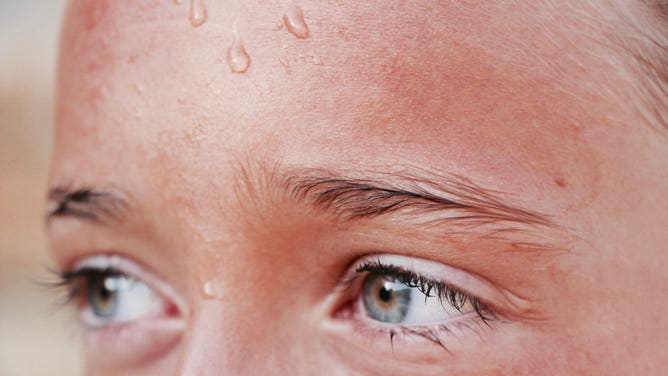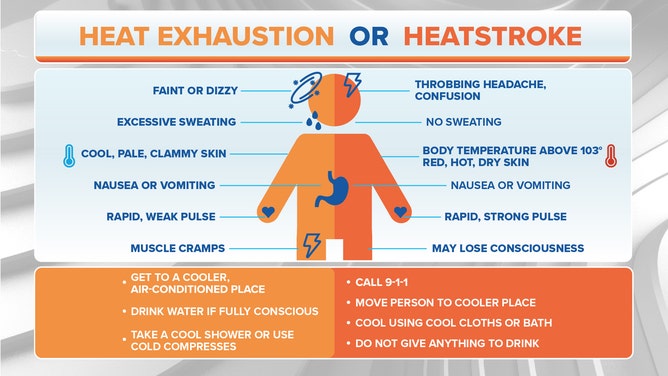How to tell the difference between heat exhaustion and heatstroke
The two heat-related illnesses can appear very similar, but have dangerously different outcomes
Heatstroke and heat exhaustion are both caused by the body overheating. However, there are important distinctions between the two — distinctions that, when made, can help save lives.
Why an ideal temperature is ideal
The human body operates best when its internal temperature is between 97 and 99 degrees. Within this narrow range, processes from the cellular level to organ systems can function smoothly. Outside of the range, these processes can be disrupted, resulting in devastating effects like decreased blood flow and organ failure.

Because of these high stakes, the body employs certain cooling mechanisms to help regulate its internal temperature. For example, when the body becomes too hot, it may begin to sweat as a way to help the body cool off.
Responses like these sometimes aren’t enough to maintain the body’s ideal temperature, causing certain functions to begin to shut down. In fact, when the body overheats, these disruptions can lead to heat exhaustion and heatstroke.
Heat exhaustion

Heat exhaustion is "a condition whose symptoms may include heavy sweating and a rapid pulse," according to the Mayo Clinic. It’s caused by "exposure to high temperatures, particularly when combined with high humidity, and strenuous physical activity."
There are several symptoms of possible heat exhaustion, such as dizziness, headache, nausea, fatigue, cold and clammy skin and a weak, rapid pulse.
Treatments of heat exhaustion include finding ways to cool off, such as moving to a shady or an air-conditioned location, drinking cool sports drinks or water, showering or soaking in cool water and removing heavy and constricting clothes. If these treatments do not begin to lower the body’s temperature within an hour, medical attention must be called.
How to beat the heat
Deputy Assistant Secretary with the U.S. Department of Labor Jim Frederick on how to protect your body during warm spells.
The people most at risk of experiencing heat exhaustion are children and the elderly, individuals who are obese and individuals taking medications that affect the body’s cooling mechanisms. People not accustomed to hot climates are also at risk, in addition to those exposed to both high temperatures and high levels of humidity.
If left untreated, heat exhaustion can escalate and lead to heatstroke.
Heatstroke
Unlike heat exhaustion, heatstroke is a life-threatening condition. It involves the body temperature rising up to about 103 degrees or higher, harming the central nervous system.
Doctors say heatstroke can be difficult to diagnose because it shares similar symptoms to heat exhaustion, such as dizziness, headaches and nausea. What sets heat strokes apart from heat exhaustion are symptoms such as hot or dry skin and a fast, strong pulse, according to the Centers for Disease Control.
On average, 37 children die each year due to vehicular heatstroke.
— National Weather Service (@NWS) July 3, 2018
✅ Keep your car locked when you are not in it so kids don't gain access
✅ Create reminders. Put your left shoe in the back seat next to your child
✅ If you see a child alone in a car, call 911 pic.twitter.com/k180pOnXeS
Doctors say that people who might have heatstroke should seek emergency medical care immediately. While waiting for medical help to arrive, the CDC recommends trying to lower the individual’s temperature by putting them in a cool bath, placing cool cloths on them and moving them to a cooler location.

Information from the National Weather Service
The CDC also advises against giving a person suffering from heatstroke anything to drink. However, the Mayo Clinic recommends giving them cool water to rehydrate, but not very cold drinks, as they can cause muscle cramps.
As with any medical issue, it’s recommended that you check with your own physician for advice.
Individuals most at risk of suffering from a heat stroke often include those who are also at risk of suffering from heat exhaustion: children and the elderly, obese people and those taking medications that may impede the body’s cooling mechanisms, according to the Mayo Clinic.

